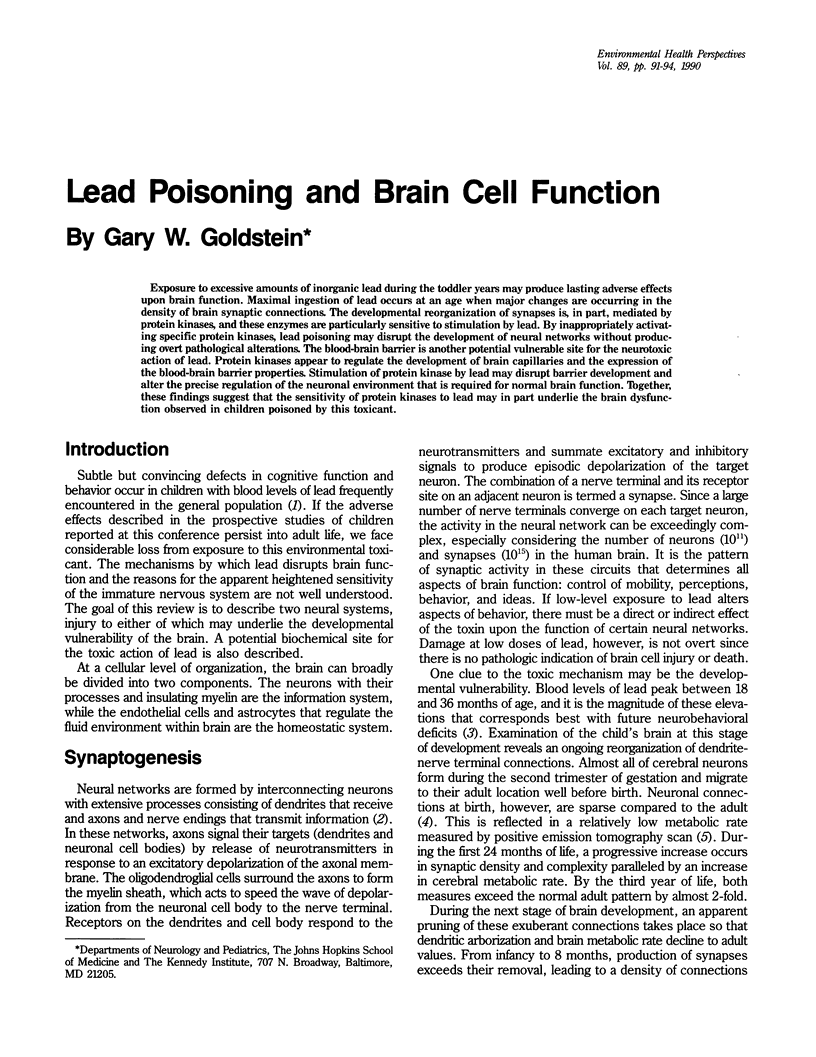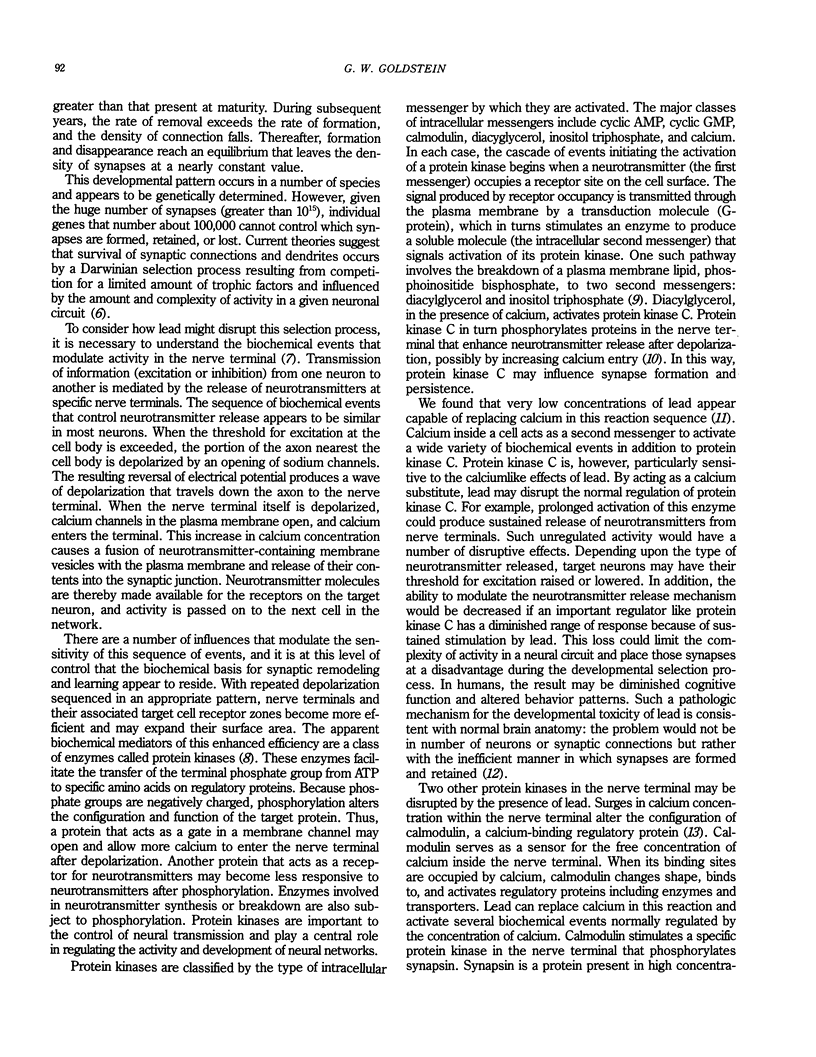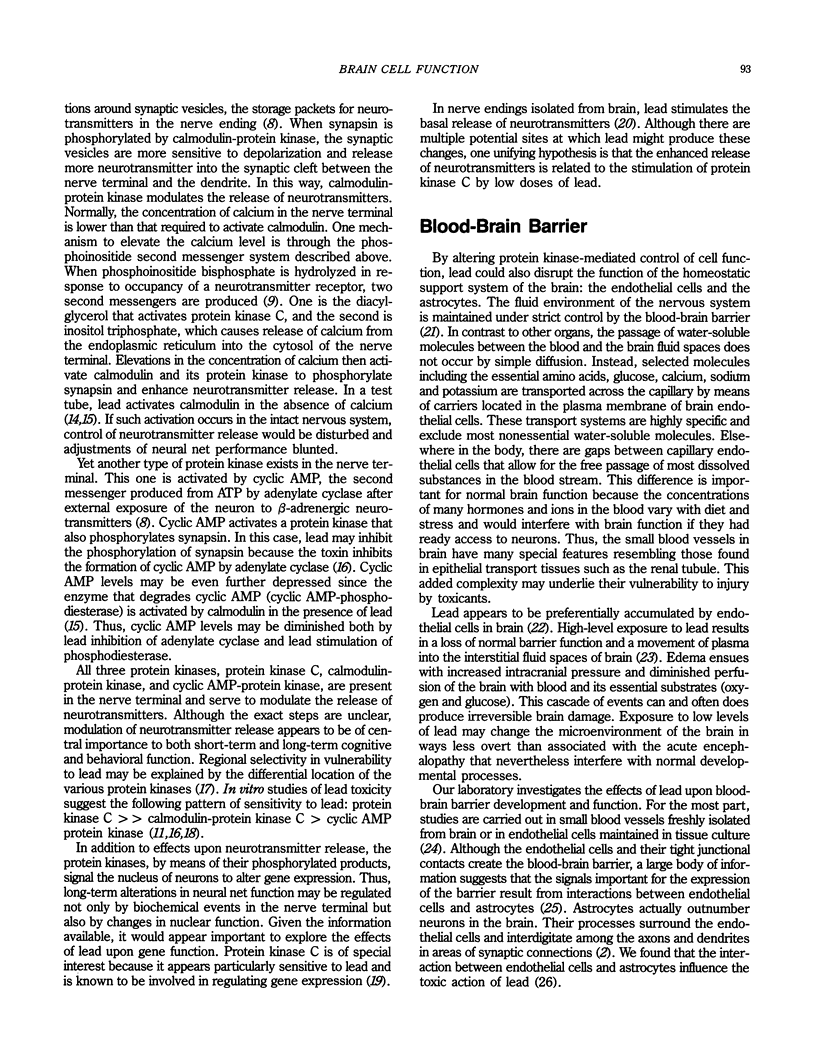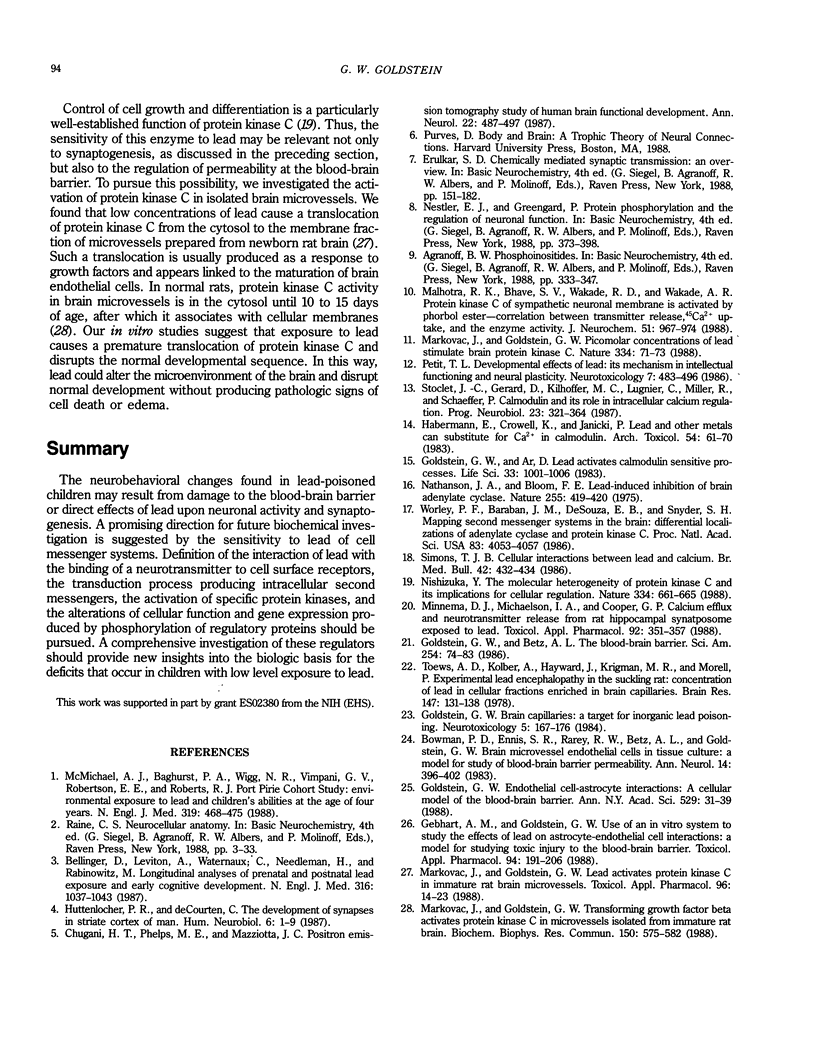Abstract
Exposure to excessive amounts of inorganic lead during the toddler years may produce lasting adverse effects upon brain function. Maximal ingestion of lead occurs at an age when major changes are occurring in the density of brain synaptic connections. The developmental reorganization of synapses is, in part, mediated by protein kinases, and these enzymes are particularly sensitive to stimulation by lead. By inappropriately activating specific protein kinases, lead poisoning may disrupt the development of neural networks without producing overt pathological alterations. The blood-brain barrier is another potential vulnerable site for the neurotoxic action of lead. Protein kinases appear to regulate the development of brain capillaries and the expression of the blood-brain barrier properties. Stimulation of protein kinase by lead may disrupt barrier development and alter the precise regulation of the neuronal environment that is required for normal brain function. Together, these findings suggest that the sensitivity of protein kinases to lead may in part underlie the brain dysfunction observed in children poisoned by this toxicant.
Full text
PDF



Selected References
These references are in PubMed. This may not be the complete list of references from this article.
- Bellinger D., Leviton A., Waternaux C., Needleman H., Rabinowitz M. Longitudinal analyses of prenatal and postnatal lead exposure and early cognitive development. N Engl J Med. 1987 Apr 23;316(17):1037–1043. doi: 10.1056/NEJM198704233161701. [DOI] [PubMed] [Google Scholar]
- Bowman P. D., Ennis S. R., Rarey K. E., Betz A. L., Goldstein G. W. Brain microvessel endothelial cells in tissue culture: a model for study of blood-brain barrier permeability. Ann Neurol. 1983 Oct;14(4):396–402. doi: 10.1002/ana.410140403. [DOI] [PubMed] [Google Scholar]
- Chugani H. T., Phelps M. E., Mazziotta J. C. Positron emission tomography study of human brain functional development. Ann Neurol. 1987 Oct;22(4):487–497. doi: 10.1002/ana.410220408. [DOI] [PubMed] [Google Scholar]
- Gebhart A. M., Goldstein G. W. Use of an in vitro system to study the effects of lead on astrocyte-endothelial cell interactions: a model for studying toxic injury to the blood-brain barrier. Toxicol Appl Pharmacol. 1988 Jun 30;94(2):191–206. doi: 10.1016/0041-008x(88)90261-x. [DOI] [PubMed] [Google Scholar]
- Goldstein G. W., Ar D. Lead activates calmodulin sensitive processes. Life Sci. 1983 Sep 5;33(10):1001–1006. doi: 10.1016/0024-3205(83)90757-9. [DOI] [PubMed] [Google Scholar]
- Goldstein G. W., Betz A. L. The blood-brain barrier. Sci Am. 1986 Sep;255(3):74–83. doi: 10.1038/scientificamerican0986-74. [DOI] [PubMed] [Google Scholar]
- Goldstein G. W. Brain capillaries: a target for inorganic lead poisoning. Neurotoxicology. 1984 Fall;5(3):167–175. [PubMed] [Google Scholar]
- Goldstein G. W. Endothelial cell-astrocyte interactions. A cellular model of the blood-brain barrier. Ann N Y Acad Sci. 1988;529:31–39. doi: 10.1111/j.1749-6632.1988.tb51417.x. [DOI] [PubMed] [Google Scholar]
- Habermann E., Crowell K., Janicki P. Lead and other metals can substitute for Ca2+ in calmodulin. Arch Toxicol. 1983 Sep;54(1):61–70. doi: 10.1007/BF00277816. [DOI] [PubMed] [Google Scholar]
- Huttenlocher P. R., de Courten C. The development of synapses in striate cortex of man. Hum Neurobiol. 1987;6(1):1–9. [PubMed] [Google Scholar]
- Malhotra R. K., Bhave S. V., Wakade T. D., Wakade A. R. Protein kinase C of sympathetic neuronal membrane is activated by phorbol ester--correlation between transmitter release, 45Ca2+ uptake, and the enzyme activity. J Neurochem. 1988 Sep;51(3):967–974. doi: 10.1111/j.1471-4159.1988.tb01834.x. [DOI] [PubMed] [Google Scholar]
- Markovac J., Goldstein G. W. Lead activates protein kinase C in immature rat brain microvessels. Toxicol Appl Pharmacol. 1988 Oct;96(1):14–23. doi: 10.1016/0041-008x(88)90242-6. [DOI] [PubMed] [Google Scholar]
- Markovac J., Goldstein G. W. Picomolar concentrations of lead stimulate brain protein kinase C. Nature. 1988 Jul 7;334(6177):71–73. doi: 10.1038/334071a0. [DOI] [PubMed] [Google Scholar]
- Markovac J., Goldstein G. W. Transforming growth factor beta activates protein kinase C in microvessels isolated from immature rat brain. Biochem Biophys Res Commun. 1988 Jan 29;150(2):575–582. doi: 10.1016/0006-291x(88)90432-9. [DOI] [PubMed] [Google Scholar]
- McMichael A. J., Baghurst P. A., Wigg N. R., Vimpani G. V., Robertson E. F., Roberts R. J. Port Pirie Cohort Study: environmental exposure to lead and children's abilities at the age of four years. N Engl J Med. 1988 Aug 25;319(8):468–475. doi: 10.1056/NEJM198808253190803. [DOI] [PubMed] [Google Scholar]
- Minnema D. J., Michaelson I. A., Cooper G. P. Calcium efflux and neurotransmitter release from rat hippocampal synaptosomes exposed to lead. Toxicol Appl Pharmacol. 1988 Mar 15;92(3):351–357. doi: 10.1016/0041-008x(88)90175-5. [DOI] [PubMed] [Google Scholar]
- Nathanson J. A., Bloom F. E. Lead-induced inhibition of brain adenyl cyclase. Nature. 1975 May 29;255(5507):419–420. doi: 10.1038/255419a0. [DOI] [PubMed] [Google Scholar]
- Nishizuka Y. The molecular heterogeneity of protein kinase C and its implications for cellular regulation. Nature. 1988 Aug 25;334(6184):661–665. doi: 10.1038/334661a0. [DOI] [PubMed] [Google Scholar]
- Petit T. L. Developmental effects of lead: its mechanism in intellectual functioning and neural plasticity. Neurotoxicology. 1986 Summer;7(2):483–495. [PubMed] [Google Scholar]
- Toews A. D., Kolber A., Hayward J., Krigman M. R., Morell P. Experimental lead encephalopathy in the suckling rat: concentration of lead in cellular fractions enriched in brain capillaries. Brain Res. 1978 May 19;147(1):131–138. doi: 10.1016/0006-8993(78)90777-1. [DOI] [PubMed] [Google Scholar]
- Worley P. F., Baraban J. M., De Souza E. B., Snyder S. H. Mapping second messenger systems in the brain: differential localizations of adenylate cyclase and protein kinase C. Proc Natl Acad Sci U S A. 1986 Jun;83(11):4053–4057. doi: 10.1073/pnas.83.11.4053. [DOI] [PMC free article] [PubMed] [Google Scholar]


